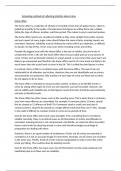Summary
Summary Criminology Unit 1 AC 1.6 - evaluating methods of collecting statistics about crime
- Module
- Criminology
- Institution
- Criminology
WJEC Criminology Unit 1 - AC 1.6 - evaluating methods of collecting statistics about crime Complete summary full marks
[Show more]




